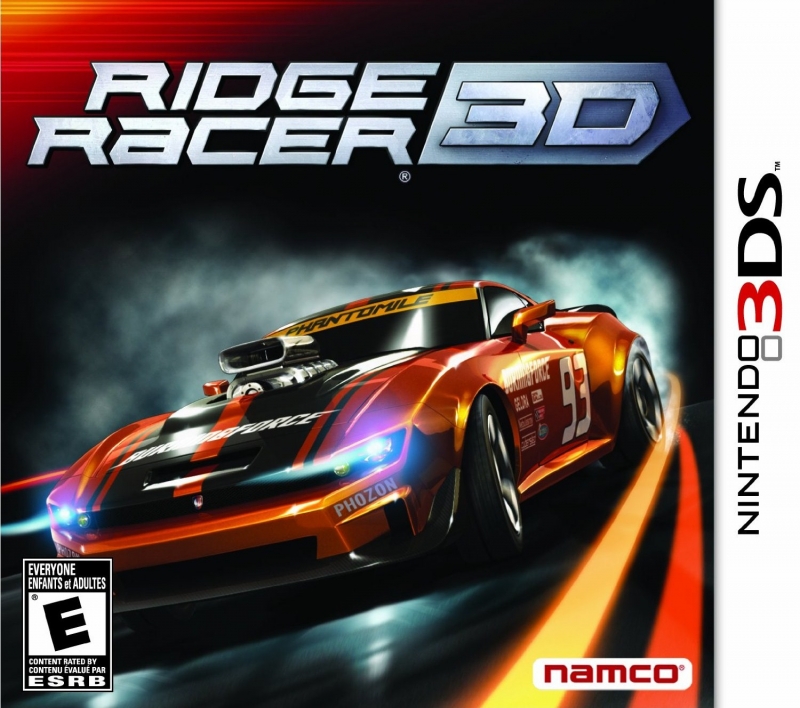
Ridge Racer 3D - Review
by VGChartz Staff , posted on 19 May 2011 / 6,520 ViewsNowadays whenever a new major videogame console launches a new entry in the Ridge Racer franchise seems like a foregone conclusion (except for the Wii apparently). Namco Bandai’s long running arcade racer keeps up the tradition on Nintendo’s new 3DS handheld with the release of Ridge Racer 3D. This new entry looks great and plays just as well as past iterations. Sadly, the game is too formulaic and recycles many elements of past iterations which diminishes its appeal somewhat, even though it is currently the best racer available on the 3DS.
The game's sound design is well done except for the race announcers. Notice I said “announcers”, plural, meaning there are more than one. To my knowledge no racing game has ever had an announcer that was not annoying and Ridge Racer 3D thinks it can get away with two of them. A male voice counts down to the start of the race and then announces how many laps are remaining every time you complete one. Then there is a female voice who gives a play by play commentary of your performance during the race. She tells you useful but obvious pieces of information, such as when you have a nitrous boost available or when you enter another racer’s slipstream, or they yours. But she also heckles your poor performance and then does a complete 180° when you do well. She is annoying, grating, and unnecessary. Thankfully you can turn the announcers’ volume down or toggle them off completely and enjoy the rest of the sound.
The music consists of Ridge Racer's classic techno infused score. The cars purr nicely as they race down the track at breakneck speeds. Brakes screech wildly as you drift around sharp corners and the jump to a nitrous boost produces a hypnotic sound effect emphasizing your speed.
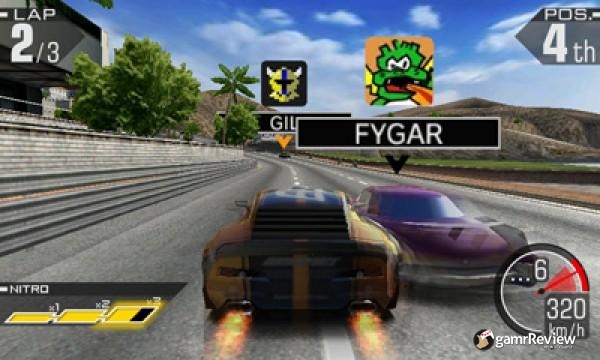
Driving in Ridge Racer is built around a drift mechanic absolutely essential to succeeding in the game. Initiating a drift requires you to slightly decelerate heading into a corner then re-accelerate as soon after the turn as possible. Drifting allows you to maintain your speed while cornering because other racers will overtake you easily if you brake foolishly. Your primary goal while drifting is to nudge the steering so your vehicle is properly oriented once it is done skidding across the pavement. If you oversteer, your car could potentially exit the corner sideways, slowing you down. The more you play around with it, the more intuitive the drift mechanic becomes, so instead of tapping the brakes as you enter a corner you learn to put less pressure on the gas and steer your way through the turn. The game also offers a one-button drift control function which eases the learning curve for beginners but feels less satisfying. As with all Ridge Racer titles the drifting is addictive and eventually becomes second nature.
Drifting also increases the amount of nitrous oxide in your reserves. With the press of a button you can use up to three tanks of boost at a time, which rockets your car to insane speeds, helping you pass the more difficult racers. Strategic use of your nitrous boost and how you drift to earn it is vital to winning races. The more you race with a car the more options you have to tailor these mechanics to you preferences. You can choose options that alter how much boost you earn when drifting and how your nitrous reserves are set up. The default setting has three tanks that you can use only if at least one tank is full but there are alternatives, such as Flex nitrous, which allows you to boost with any amount of nitrous in your tank, or Quad nitrous, which gives you one extra tank to race with.
Another important racing mechanic is taking advantage of the slipstream. By driving directly behind an opponent up to a certain distance, your car accelerates faster and reaches a higher top speed. This allows you to close the gap between the racer ahead of you until you are just about touching their rear bumper and then slingshot around them. A sleek little meter shows when you’ve entered the slipstream and fills up depending on how effectively you take advantage of it. Other cars will take advantage of your own slipstream if you give them the chance.
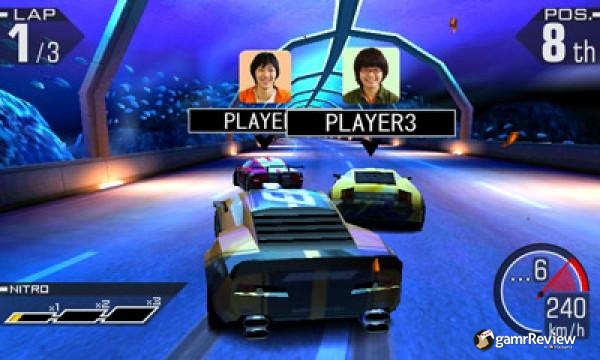
The default controls are tight and easy to learn. There are many different control options available for those looking for something more comfortable. Tapping the touch screen allows you to change your camera and the view of the track as you race. The 3DS slide pad feels remarkably responsive for steering and the D-pad is also available, though not recommended. There are different commands for using one, two, are all three of your nitrous tanks. Using just one is assigned to the R button, two to the L button, and all three by pressing them together.
There are four different categories of vehicles that you work your way through. Using points you earn from winning races you can buy new cars for your garage. Before racing you can also purchase support items that give you an in-race advantage, such as a rocket boost off the starting line or pre-filled nitrous tanks.
Races consist of eight competitors with the player invariably at the back of the pack. The only other racer marked on your map is the lead car that starts off with a sizeable head start that it is your job to overcome. There is no penalty for crashing into other racers or a wall other than sparks and paint chips superficially flying off your car, along with a slight decrease in speed. The cars handle well at high speeds as if they are magnetized to the track aside from the occasional jump.
Singleplayer racing options include Quick Tour, which generates a sequence of races based on the desired length of play and course type. There is One Make Race where you race against 7 opponents all with the same machine as you. Then there are Time Attack and Standard Race modes.
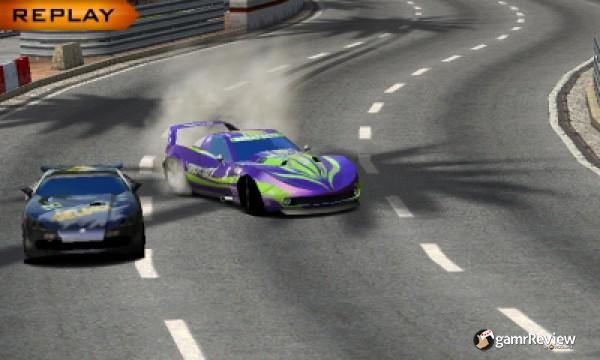
The main singleplayer mode consists of completing in 48 racing tours across three different Grand Prix levels. The racing tours usually have four races where you must finish in the qualifying position to progress. Typically the qualifying position for the first two races is 3rd place, then 2nd and 1st for the remaining two. This pattern repeats for the majority of the races. As you complete more events you unlock new vehicles, courses, and upgrades. More difficult races generally require faster category vehicles.
It is not until the final Gran Prix where the formula is shaken up a bit. The field of racers is reduced from eight to four and you must place 1st in each race. There are a few elimination style races where the car in last place is eliminated after each lap and even a few 1-on-1 duels against special concept cars. The slight change-up in the gameplay towards the end of the singleplayer is nice but it is not enough to mask how repetitive the experience can feel.
The multiplayer allows you to race up to three of your friends locally via Wi-Fi versus mode. Neither online nor download are available, which is a shame because both features would have extended the longevity of the title. Through StreetPass you can exchange data with other nearby 3DS owners, allowing you to race against their ghost data for points.
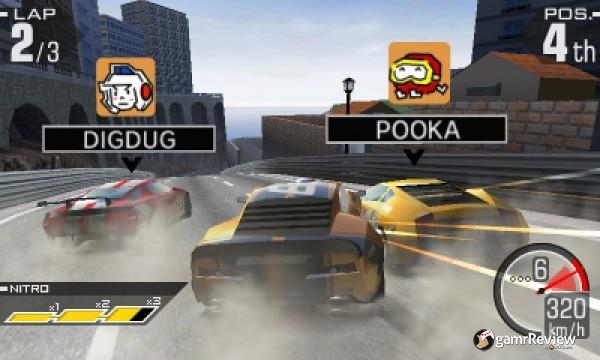
Ridge Racer 3D is a solid experiences hurt by how recycled and repetitive its content is. The game lasts a long time; the Gran Prix mode alone is 150 races long, and that takes more than 12 hours to complete. There are 15 courses in total and you will race on them repeatedly in forward, reverse, and eventually mirrored versions. It doesn't help that a lot of these courses are classics that have been reused in most iterations of the game. Even some of the fictional roster of cars should be familiar to Ridge Racer fans and that includes the special concept cars as well. I enjoyed playing Ridge Racer 3D a lot but I felt like I had played it many times before. This should not discourage newcomers to the series from checking it out and potentially having a blast. The game looks slick and plays well, which is why it's currently the best racing game available on the 3DS.
VGChartz Verdict
7.6
Good
























